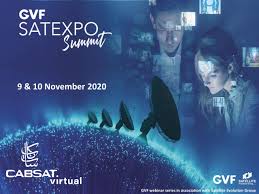Virtual CABSAT 2020 in ‘GVF’s CyberSpace’
Dubai, UAE, November 9, 2020--With a total of more than 2,700 views on the GVF YouTube channel of the recorded webinars of the GVF-Satellite Evolution Series, in addition to the views of the live broadcasts over Zoom every alternate Thursday, the series continues to draw some significant audiences, now regularly from over 120 countries. The series has been widely recognized for its professional production approach to presentation and for the quality of its dialogues.
Since I wrote about the 24 September webinar Global Transitions: Digital Economy, Digital Infrastructure, Connected Communities, Digital Planet which included a contribution from the UN, no less, we have had two further moderator-led dialogues in the GVF series, and two further webinars produced for the program of the virtual ConnecTechAsia 2020.
In the GVF main series A Regional Perspective on C-Band – The Next Battleground? brought an important re-focus to the subject of competition for satellite spectrum amongst a variety of other topics, and following on 22 October was The Regional Satellite Operators’ Voice.
Then 5 November will bring Humanitarian Assistance & Disaster Response: The Evolving Role of Satellites in Disaster Response. Recordings of all these events can be sourced at https://gvf.org/webinars/.
 The webinars produced for the program of the virtual ConnecTechAsia 2020, are not the only content produced for insertion into events with which GVF regularly partners, and which the pandemic has driven into cyberspace. GVF always has a big profile at CABSAT, with each year of the in-person exhibitions featuring an embedded GVF Summit. The month of March saw CABSAT 2020 postponed to October; October saw the physical exhibition put back until May 2021; but, November 2020 sees Virtual CABSAT 2020, within which GVF will present its own virtualized content in the form of pre-recorded sessions.
The webinars produced for the program of the virtual ConnecTechAsia 2020, are not the only content produced for insertion into events with which GVF regularly partners, and which the pandemic has driven into cyberspace. GVF always has a big profile at CABSAT, with each year of the in-person exhibitions featuring an embedded GVF Summit. The month of March saw CABSAT 2020 postponed to October; October saw the physical exhibition put back until May 2021; but, November 2020 sees Virtual CABSAT 2020, within which GVF will present its own virtualized content in the form of pre-recorded sessions.
Virtual CABSAT…
In the first of these GVF Secretary General, David Meltzer, will be in conversation with a representative of the International Telecommunication Union Radiocommunication Bureau. ‘In Conversation with ITU: The GVF Asks...’ will feature Mehtap Dufour, Senior Radiocommunication Engineer with the Satellite Systems Coordination Division of the Space Services Department, who was originally scheduled as one of the GVF SATEXPO Summit keynote speakers at the March 2020 event.
Questions are planned to revolve around how WRC-19 satellite-related outcomes of particular interest for the MENA region have played out over the last 12 months and looking ahead to WRC-23 at key and pivotal satellite-related agenda items; trends and discernable patterns in ITU orbital slot filings, both global and MENA-specific; the satellite industry’s role in mitigating the economic and societal effects of the pandemic being recognized and enshrined in future decisions on spectrum allocation; the commercial satellite communications industry’s focus on frequency bands beyond the established use of C-, Ku- and Ka-band; the increasing integration of satellite communications and satellite remote sensing/Earth observation impact on global regulatory environment and the work of the ITU.
In the first of two panel sessions the focus will be on ‘Satellite’s Disruptive Evolution | In Orbit, On Earth’. Featuring David Meltzer as moderator, the panel will comprise Dave Rehbehn, VP International Division, Hughes Network Systems; Simon Gray, SVP Humanitarian Affairs, Eutelsat; Imran Malik, VP Global Sales Fixed Data, SES; and, Michael Di Paolo, Director of Business Development, SpaceBridge.
The term “disruptive evolution” has an established place in satellite industry dialogs. In-orbit technology is changing, quickly and in a big way. Along with some of the very latest GEO satellites about to achieve near-terabit throughput capacity (and at much reduced cost per Gbps), existing MEO constellations evolving into more powerful systems, and the first spacecraft of the LEO mega-constellations already orbited, the capabilities of the space segment are increasingly matching the bandwidth requirements of an increasingly inter-connected broadband world.
Space infrastructure on the ground is also undergoing a game-changing shift. Amongst other trends, teleports are evolving, and antennas/terminals are expected soon to feature a long-awaited cost-effective form-factor and performance departure from the traditional parabolic paradigm.
Likely questions for this discussion will be:
- How are the capabilities of the space segment increasingly matching the bandwidth requirements of an increasingly inter-connected broadband world?
- How are GEO satellites evolving, in terms of their changing capabilities and in terms of the relationship between their investment cost and performance returns on that investment? [3] Are the emerging NGSO constellations a competitive threat to existing GEO and MEO, or an evolution of complementary in-orbit capabilities to further extend satellite’s reach into newer markets?
- What are the principal and pivotally game-changing characteristics of the evolution in infrastructure in the ground segment, including teleports, which will most impact the space segment?
- What are the specific space segment innovations that Hughes, Eutelsat, and SES are currently developing and rolling out? [6] New antenna technologies have long-been keenly awaited, but just how critical are they to the future expansion and growth of the satellite industry in serving the needs of legacy and new end-user vertical markets?
- For which of these end-user vertical markets, both established and emerging, are the new antenna technologies the most critical?
- Does any one variant of the new terminal technologies represent a particularly outstanding solution to the industry’s and customers’ needs?
- Which end-user applications require ground segment innovation because the new antenna technologies do what parabolic antennas cannot, and how does this vary between, say, aeronautical, maritime and land mobile?
- What are the key characteristics/factors/features of how the new antenna technologies work that make them such an important advance?
The second panel discussion will feature Alvaro Sanchez, CEO, Integrasys; Jack Buechler, VP Business Development & Product Management, Talia; Nicholas Laughton, Manager Systems Operations LEO, Telesat; and, Joel Schroeder, Director Land Mobile, Intelsat. Moderated by yours truly, the dialogue theme will be ‘Satellite’s Resilience Evolution |Challenging Markets, Robust Connections’.
Whether it’s a question of rapidly evolving legacy and emergent user-market demand drivers, or of the responses of the satellite industry to these demand pressures, the satcoms industry is in dynamic flux and its resilience is being put to the test on different fronts. Customer/user-markets such as aeronautical, maritime, and military, are all exhibiting greater demands from their satellite connections, and the satellite industry is bringing elevated technology and service capabilities to the market in response. Users of satellite networks depend on the reliable and robust connectivity that is characteristic of today’s platforms, but there are potential vulnerabilities. This session will explore the current state-of-play in relation to two of those potential vulnerabilities. Cybersecurity is a vulnerability far from being specific to satellite and is a core concern across the entirety of the IP-enabled global ICT infrastructure. This session will explore satellite-based services in support of cyber security and to assess technical feasibility and commercial viability for diverse, current and future, vertical sector users of satellite. Interference is a vulnerability that the satellite industry has been successfully addressing through both technology advance and human capacity-building.
Potential questions to be tackled here are:
- In describing the satellite industry as “resilient” to changes in, and challenges presented by, the end-user markets it serves, what does this mean for you? How is this resilience evolving and being put to the test in the face of newer markets and different challenges?
- Let’s take a look at some currently challenging markets. Focus, if you would, on the various markets with which you are each, respectively, most familiar. Which aspects of those markets most preoccupy your organization in terms of ability to meet customer demand?
- When customers present challenging demands, does it more often focus on technology performance and future proofing, or on service guarantee quality and flexibility?
- In your analysis and from your perspective when you employ the descriptions of satellite communications as “reliable” and “robust”, what do you mean to convey with those terms?
- Given that “reliable” and “robust” can never mean invulnerable, what are the kinds of vulnerability that currently concern you? Is the vulnerability landscape changing?
- Assuming that this landscape is in dynamic flux, what evolving threats do you perceive as soon to present newer challenges?
- Let’s take the example of cybersecurity. It must naturally be significant concern across all end-user verticals, but how does this concern manifest itself in specific individual markets and what do different customers expect satellite to deliver? Related to this, are cybersecurity concerns featuring in QoS agreements and guarantees?
- Interference is a multi-faceted issue, from adjacent satellite interference to terrestrial mobile wireless interference. Where do you see the greatest continuing threat, how are interference problems evolving, are present prevention and mitigation strategies enough, and what more can/needs to be done?
- For each of the space segment and ground segment, where, in your opinion, are the most important innovations facilitating improvements in networks robustness?
- Are there any particular features of the MENA market which present regionally specific issues relating to market challenges and connectivity/applications robustness?
For now, with these analyses, the Webinar Epoch goes on!
-----------------------------------------------
 Martin Jarrold is Vice-President of International Program Development of GVF. He can be reached at: martin.jarold@gvf.org
Martin Jarrold is Vice-President of International Program Development of GVF. He can be reached at: martin.jarold@gvf.org






